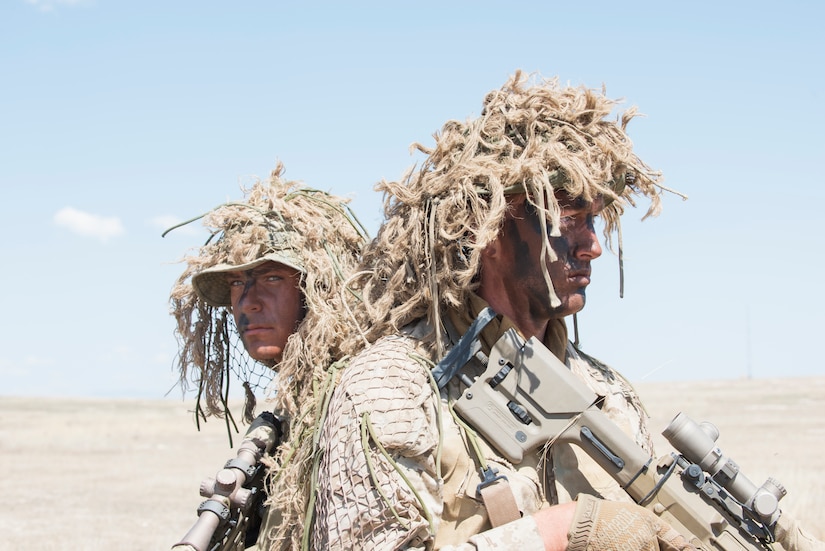By Air Force Master Sgt. Becky Vanshur, 124th Fighter Wing
ORCHARD COMBAT TRAINING CENTER, Idaho -- Hidden beneath
twigs and weeds, the three snipers’ stomachs are flat on the ground with dirt
and grime on their faces.
It’s a 90-degree day. A drip of sweat rolls down into the
lead sniper’s eye, stinging and smearing the camouflage paint on his face.
The sniper does not blink amid the stillness.
‘I Have Eyes on the Target’
“I have eyes on the target,” faintly whispers Army Staff
Sgt. Matt Koerner, lead sniper section sergeant. “Calling it in.”
The Idaho Army National Guard was recently tasked with
forming a small sniper scout platoon, a first for 2nd Battalion, 116th Cavalry
Brigade Combat Team.
“It’s our very first sniper platoon for Idaho, and one of
the challenges is finding qualified individuals,” said Army Maj. Jason Gracida,
2-116 battalion commander. “Once we get them through sniper school, they can
come back and teach those younger future snipers.”
The job of a sniper requires extensive training, attention
to detail and complete discipline with stillness. Snipers risk exposure if they
move too quickly.
The platoon, established a year ago, started with two
previously qualified instructors. This year’s training coincides with the
brigade’s two-week annual training at the Orchard Combat Training Center here.
The two qualified snipers have spent the previous year training the new
platoon.
“Our instructors have done a fantastic job training the
platoon and putting them through the ringer. Those two have worked tirelessly
to get them ready for their first lane today,” Gracida said. “This is the first
time they have ever actually employed sniper lanes, heading toward a certain
area to begin their stalk.”
‘Vegged Up’
Stalking is a stealthy, slow business. The sniper pays
attention with an extreme amount of focus for details to remain undercover and
hidden. Creeping slowly, inch by inch, can take up to two hours just to move 10
feet. Snipers wear a ghillie suit, which is a uniform sewn together with fabric
resembling vegetation to blend in with their surroundings.
Hidden beneath twigs and weeds, a sniper’s stomach is flat
on the ground, dirt and grime on his face. All that can be seen in the bundles
of cheatgrass is a pair of steady, intense eyes.
“It’s called vegged up. We grab weeds and sticks from the
environment, [then] cut them and attach them to the ghillie suit,” Koerner
said.
Using high-powered binoculars and rifle scopes to scout the
surrounding area, the snipers will locate the high-value target and call the
battalion commander to report the target has been found. Then, the sniper will
wait for further instruction.
“Today, they will go out and start their lane. It is a
2,000-meter stalk. They will ghillie suit up and basically low crawl through
the dirt throughout the evening. By morning, they will have identified their
target and call it in to me,” Gracida said.
Slowly reaching up with his hand, Koerner grabs a thick
branch of sagebrush and prepares for the final stages of movement. The team is
now in a sniper’s hide where they can conduct their reconnaissance. They keep a
log of their observations and sketch the terrain, painting a picture of enemy
activity, before calling it in to their commander.
“The effective sniper team has to be able to move into an
area, remain undetected and report enemy activity. Get in and get out, unseen,”
Koerner said.









No comments:
Post a Comment